Here’s the scoop on why diets are not the answer to health issues our kids may have—or concerns about their body size—and what you should do instead.

Kids and Diets
We all want to serve nutritious food to our kids—and have them actually eat it. For them to love movement and want to do it all on their own. And for them to love their bodies. But we’re also bombarded from all sides about everything we need to worry about when feeding our kids, everything that could go wrong—especially when a child falls on the higher end of the growth chart.
There’s a lot of research that shows how too much pressuring, controlling, and coercing can backfire in the big picture of raising healthy kids. And research shows how nutrition and exercise interventions don’t actually result in smaller body sizes.
So what do we do when confronted with advice that our child needs to lose weight? That it’s time to put our child on a diet, whether from your pediatrician, the school nurse, or guidelines from national health agencies?
For me, it means we look at where the advice is coming from, why it’s being directed at us, why the advice is coming now, what other contextual information may say, and whether the advice may be harmful.
Your toddler won’t eat? Help is here!
Sign up for our email updates to get tips and ideas sent to your inbox.
Meet Anna Lutz, RD
Anna Lutz, MPH, RD, of Sunny Side Up Nutrition in Raleigh, North Carolina, is a pediatric dietitian who specializes in eating disorders and family feeding with a weight-inclusive perspective. She’s such a wealth of information (and reassurance) on how to parent our kids when food issues are concerned.
She’s also very wise when it comes to noticing when you might be attempting to parent a child’s weight—or parent them in a way to make their body smaller. Her wise words:
It is not my job to control my child’s weight. I don’t need to parent perfectly for my child to have a certain weight.
My job is to model what it looks like to take care of my body and to set up a structure so children take care of the body they have. We focus on behaviors, not weight.

Do kids ever need to diet?
According to Anna: “I don’t think there’s a situation where dieting is helpful. Diets don’t work. People can restrict intake for a limited amount of time, but our bodies are meant to survive, and weight comes back on and oftentimes there’s a lot of collateral damage.”
And here’s more from Anna about that “collateral damage,” with specifics on what can happen to kids who are put on diet or have their food restricted. (Restricting foods is, at its core, the definition of dieting.)
- “They can become more obsessed about food.”
- “Their hunger and fullness cues become off.”
- “We set them up for a lifetime of weight cycling, which can be harmful.”
When a child becomes obsessed with food, they may sneak food, eat more than they are hungry for because they worry about when they’ll be allowed to have it again, and become preoccupied with food. This can also look like obsession with “healthy eating” or eating the “right” foods, especially when kids know that they get approval from adults for eating more of certain foods than others.
And all too often, this can turn into disordered eating or a full-blown eating disorder. (Eating disorders are the second leading cause of death from a mental health illness, so this risk is not one to ignore.)
It’s so hard to let the kids just be during meals and snacks and to eat according to their own hunger. Often, their hunger looks nothing like we expect it to. Those ebbs and unpredictable flows are NORMAL for kids, but what we expect something different based on the charts and plates of perfectly balanced meals we see on social media.
But if we want to raise tweens, teens, and adults who are able to eat without guilt or relying on external metrics, we need to give our younger kids the chance to flex their own intuitive eating muscles.
It’s important to remember that bodies naturally come in a range of sizes. And that we can live healthy, fulfilled lives without increased health risks at any size. That is actually what the research tells us.
It’s anti-fat discrimination that leads to the rest.
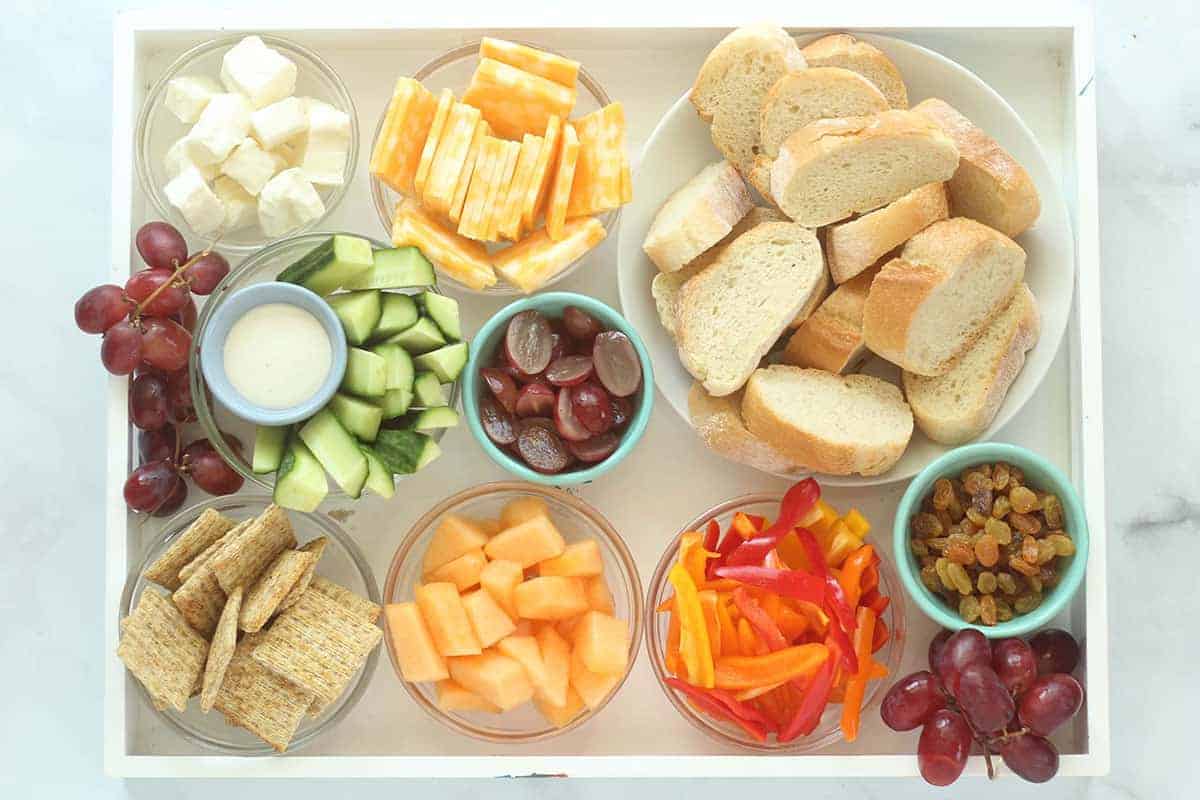
What to Do at Mealtimes
Instead of “getting” the kids to eat certain amounts of certain foods, here’s how I approach mealtimes:
- I aim to offer a variety of foods over the course of a whole week.
- At each meal, I offer small portions of foods to avoid food waste and the potential for a child to be overwhelmed by too much food on their plate.
- I try to include 1-2 foods in each meal they usually like to ensure there’s always something to fill their bellies.
- When there’s a request for more food, the child can have more if we have it.
- If a child says they are hungry, I trust them. If a child says they are full, I trust them.
- During meals, I tell them what the food is, try to let them have some power over what winds up on their plate, and then we talk about other things. No bartering, pressuring, and/or coercing food intake.
What about the “obesity epidemic”?
Remember that the way kids are classified by weight changed overnight in the 1990s. And growth charts are based primarily on Caucasian kids from the 1960s and 1980s.
“It does look like kids may be growing faster, and there could be lots of things that affect that including food,” Anna says. “But the children we have, it is not their fault if children are growing quicker. The way we’re treating the ‘obesity epidemic’ is putting the onus on these young children, which is actually causing eating problems.”
Plus, she goes on to say that the fear our culture has about weight right now sets the parent up to feel that they need to control what a child is eating—which can be damaging long-term for physical and emotional health for everyone involved.
Controlling what our kids eat is not the answer to raising healthy kids.

What do I do if my child is “overweight”?
You’d do the same you’d do for any child.
- Set them up with regular meals and snacks on a predictable schedule served at the table.
- Offer a range of foods, including their favorites and the foods you’d like them to also eat.
- Model eating a range of foods you enjoy.
- Provide regular opportunities for physical activity with a focus on having fun.
- Provide regular opportunities for kids to learn about food without pressure—from kids books about food, cooking together, gardening, shopping at the farmer’s market, or simply deciding what to make for dinner together.
- Sit together for meals (as is feasible with your life) and engage with your child about their life and yours—instead of focusing on food.
- If there are other issues challenging the child, look for help addressing them.
Remember that kids’ bodies are supposed to grow. It would be a problem if they didn’t! We can’t control how their bodies grow, but we can support them with clothes that fit and are comfortable and by not making choices based on their body size.
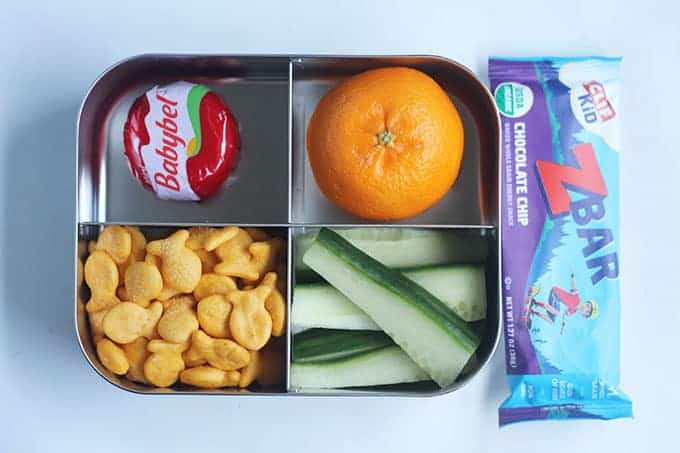
What if my child just wants snacks and “junk” food?
I know that a lot of us are worried about sugar, treats, and “snacky” foods—and how to raise healthy kids when those are the foods our kids prefer. Anna reminds us:
Take a deep breath and decide what’s within our control and what is going to be the outcome if we were to intervene. Is it going to be more harmful to say you can’t have what every other child is eating or to let them enjoy the social situation and the food?
Consider instead which foods you bring into your house and when (and how) they’re served. And think through what we’re eating over a whole week, rather than at each meal.
Anna says this can be: “A process of letting kids learn to navigate these situations and learn to trust themselves around food.” She suggests that there might be some things on a structural level we can influence without the kids ever knowing about it, such as talking to a soccer league about changing the expectations around snacks, for example.
It can also help to try not to label foods as good or bad (or “junk”), and to just call the food whatever it actually is—”snack bar,” “chips,” “yogurt,” etc.
TIP: Read more about what to do when kids want snacks, not meals.
The Role of Our Own Anti-Fatness
Parents may also be fixated on weight loss as a way to protect their kids from bullying or body shaming—because maybe those are experiences they had in their past or even in their present. But the problem is actually our culture making everyone fear large bodies.
“There’s nothing wrong with parents wanting to protect their children, but there’s nothing ethical that I can prescribe or recommend for a parent to change their child’s body,” Anna says.
Instead consider:
- “What in this home can we do to support this body that we have?”
- “How can I model body acceptance?”
- “How can I talk about about what it means for everyone to have different bodies?”
And how can I point out weight stigma and anti-fat bias when we see it so the kids can identify it, too, as they grow. With older kids who may realize that they have larger bodies than some of their friends, it can help to acknowledge their concerns. At the same time, make sure to be clear that there is nothing wrong with anyone’s body, regardless of size.
As Virginia Sole-Smith said in a recent newsletter about talking to kids about diet culture:
A diet is when people try to make their bodies smaller by eating less food. It doesn’t work and it can make you sick, especially for kids who are growing and need to eat as much food as they want…
Your body is not the problem. You don’t ever need to make yourself smaller by dieting.
(Read the full newsletter here.)
And mostly: Let them know you are always here to talk about their concerns. Be their safe space!
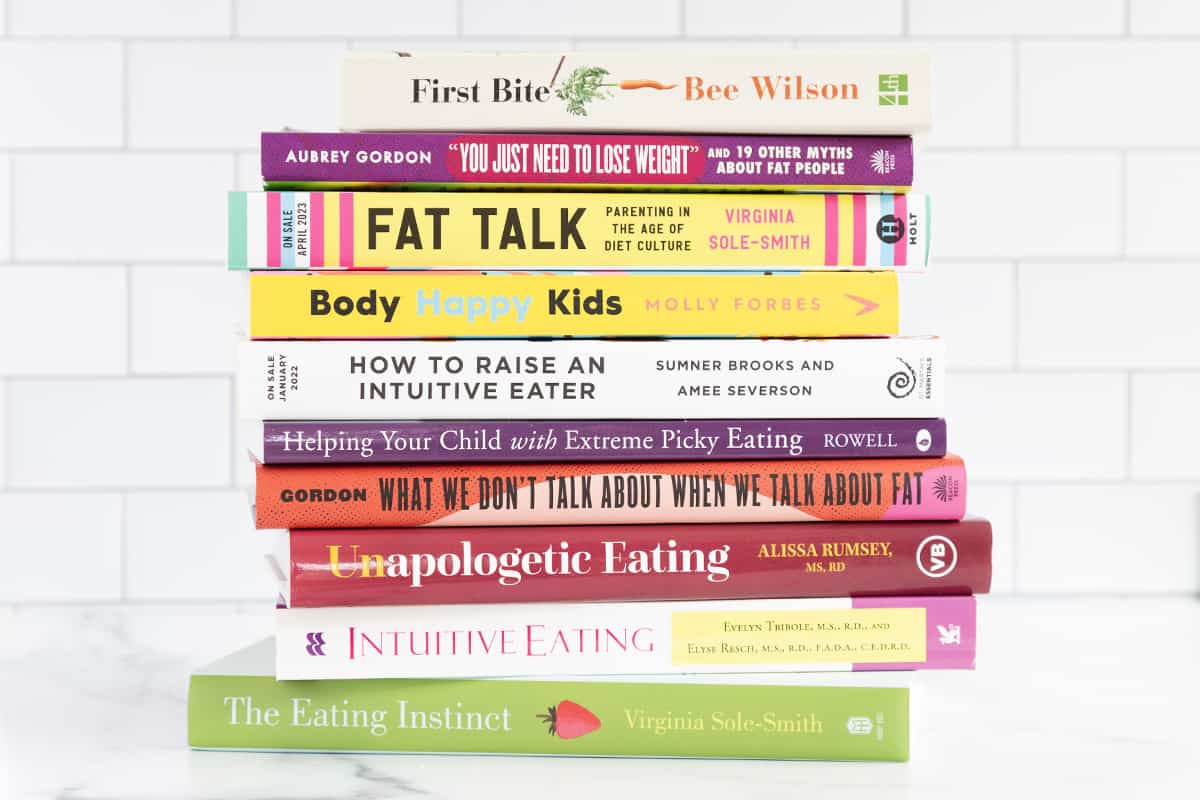
Recommended Reading
These books go much more in depth on all of these topics and fill in many gaps in my post.
- Fat Talk: Parenting in the Age of Diet Culture by Virginia Sole-Smith
- What We Don’t Talk About When We Talk About Fat by Aubrey Gordon
- “You Just Need to Lose Weight” And 19 Other Myths About Fat People by Aubrey Gordon
- Intuitive Eating: A Revolutionary Anti-Diet Approach, by Evelyn
- How to Raise an Intuitive Eater: Raising the Next Generation with Food and Body Confidence, by Amee Severson and Sumner Brooks
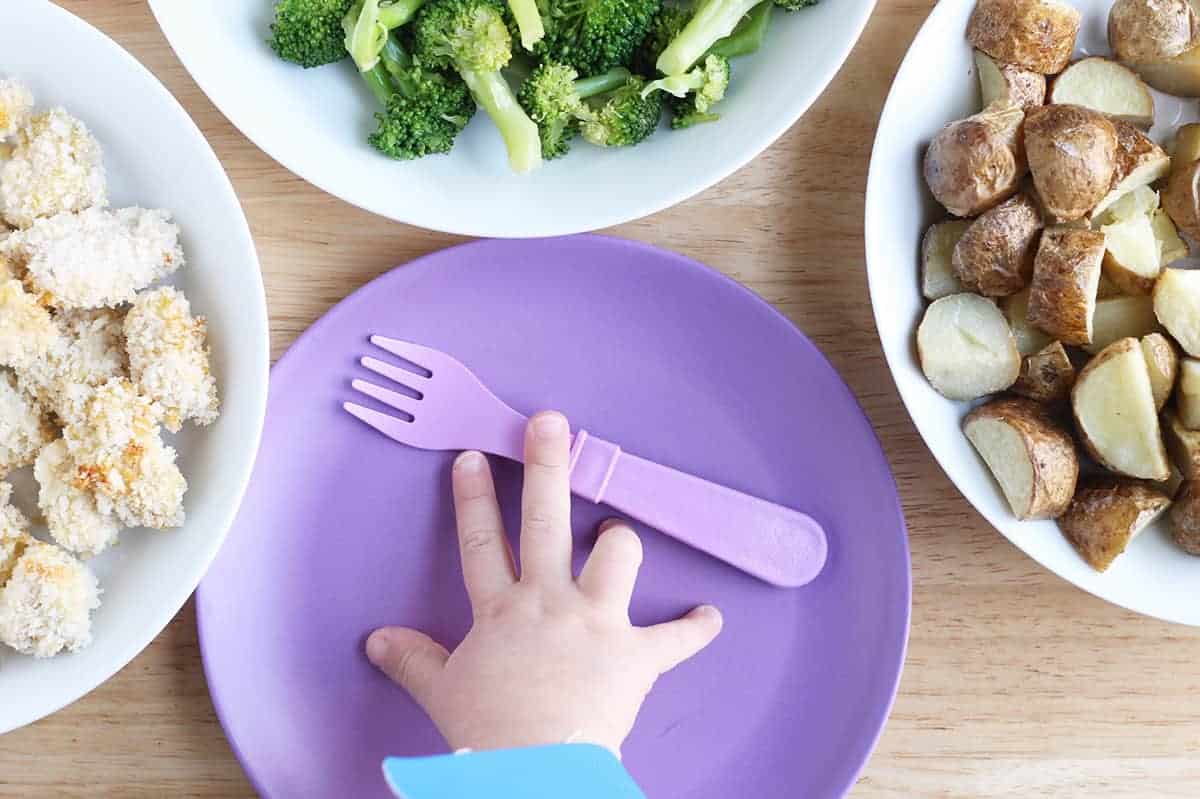
Best Kids Diet Plan
The best “diet plan” you can offer your children is to serve them a range of nutritious, delicious foods at set meal and snack times, and allow them to eat what of it they want. You can read more about this approach called the Division of Responsibility here.
It’s such a great way to have happier meals and reduce power struggles at the table. And actually get to enjoy your own food, too!
Related Posts
Questions? Comments? We’d love to hear from you so please comment below!
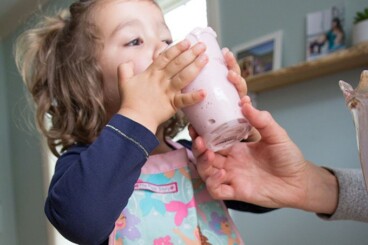
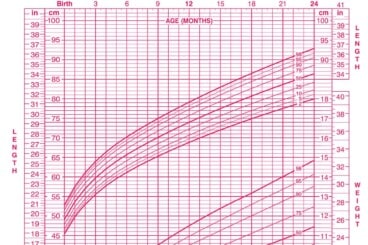

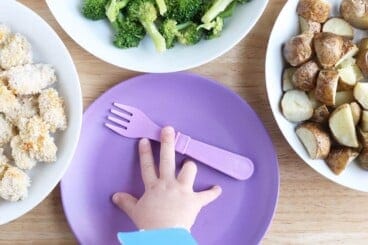
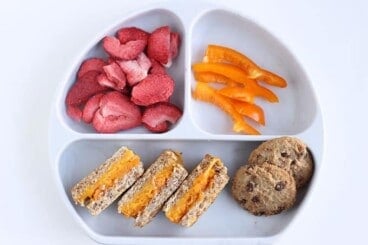

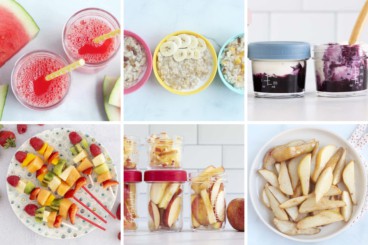
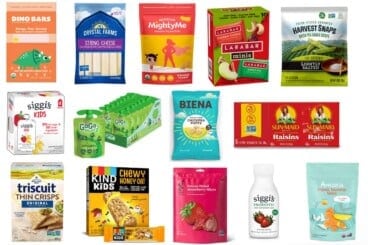



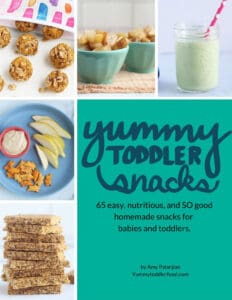















Thank you for a great article. Is there ever any need to restrict food eg my two year old will eat a large punnet of berries or a large tub of yoghurt (a whole pound) and ask for more. Do I just keep giving more / unlimited amount until he stops eating? Or do I need to be mindful of too much calcium (which I read can interfere with iron absorption) or filling up on fruit at the expense of other foods ? Appreciate any tips. At the moment he doesn’t eat meat , eggs or vegetables at all (despite regularly offering in an unpressured way) but he eats lots in the other food groups.